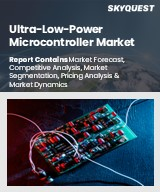
|
시장보고서
상품코드
1792349
마이크로컨트롤러 시장 보고서(2025-2033년) : 제품 유형, 아키텍쳐, 메모리, 용도, 지역별Microcontroller Market Report by Product Type, Architecture, Memory, Application, and Region 2025-2033 |
||||||
세계의 마이크로컨트롤러 시장 규모는 2024년 287억 달러에 달했습니다. 향후 IMARC Group은 시장 규모가 2033년까지 583억 달러에 이르고 2025-2033년 성장률(CAGR)은 7.55%가 될 것으로 예측했습니다. 모니터링, 진단, 치료 용도를 위한 의료기기에서의 마이크로컨트롤러의 사용 증가, 에너지 효율에 대한 수요 증가, 반도체 기술의 지속적인 발전, 인더스트리 4.0으로의 이동 증가, 제조 공정에서의 자동화 요구 증가는 시장을 추진하는 주요 요인입니다.
마이크로컨트롤러는 임베디드 시스템의 특정 동작을 제어하도록 설계된 소형 집적 회로입니다. 기본적으로 장치의 '두뇌' 역할을 하며, 소비자용 전자기기 제품, 자동차, 의료기기, 산업기계 등 다양한 자동화 제품 및 시스템에서 일반적으로 사용됩니다. 범용 컴퓨터와 달리 마이크로컨트롤러는 일련의 작업을 집중적으로 수행하며 저전력 소비에 최적화되어 있습니다. 일반적으로 프로세서, 메모리, 입출력 주변 장치 지원이 원칩에 장착됩니다. 이러한 구성 요소는 메모리에 저장된 특정 명령어 세트(펌웨어)를 실행하기 위해 함께 작동하여 마이크로컨트롤러가 지정된 기능을 수행할 수 있도록 합니다.
스마트홈, 산업환경, 자동차 시스템에 IoT 기술이 널리 채택되고 있는 것은 세계 시장의 성장을 가속하는 중요한 요인 중 하나입니다. 이는 이러한 연결된 장치의 제어 센터 역할을 하는 마이크로컨트롤러에 대한 수요를 더욱 확대시킵니다. 차량 기술 가운데 특히 전기자동차 및 자율주행 차량의 상당한 진보로 브레이크, 스티어링, 네비게이션 등 다양한 서브시스템을 관리하기 위한 마이크로컨트롤러의 사용량이 증가하고 있습니다. 스마트폰, 태블릿, 웨어러블 등의 소비자용 기기의 보급 또한 처리와 제어에 마이크로컴퓨터를 이용하면서 시장의 성장에 기여하고 있습니다. Industry 4.0 혁명과 제조 공정의 자동화가 발전함에 따라 첨단 제어 시스템이 필요하며 따라서 이러한 응용 분야에서는 마이크로컴퓨터가 필수적입니다. 신재생에너지 솔루션과 에너지 효율적인 디바이스에 대한 주목 증가는 저전력 소비에 최적화된 마이크로컨트롤러의 개발로 이어지고 있으며, 그 적용 범위가 넓어지면서 세계 시장의 성장을 가속하고 있습니다.
마이크로컨트롤러 시장 동향 및 촉진요인
사물인터넷(IoT) 기기 이용 확대
시장의 가장 큰 촉진요인 중 하나는 IoT 장치의 상승입니다. 마이크로컴퓨터는 IoT의 핵심이며 장치와 외부 환경 간의 통신을 관리합니다. 사용자의 취향에 따라 냉난방을 조정하는 스마트 홈 장치부터 기계의 동작 상태를 모니터링하는 산업 환경의 센서까지 마이크로컴퓨터는 이러한 작업의 핵심을 담당합니다. IoT 시장 자체는 전례없는 기세로 성장하고 있으며 매년 수십억 대의 연결 장치가 온라인화되고 있습니다. 헬스케어, 운송, 소비재 등 다양한 부문에 걸친 이 광범위한 IoT 장치의 네트워크는 이러한 연결 시스템의 "두뇌" 역할을 하는 마이크로컨트롤러 수요를 크게 밀고 있습니다.
자동차 산업의 현저한 진보
자동차 산업은 전동화, 자동화, 연결성으로 전환하여 변혁기를 맞이하고 있습니다. 마이크로컨트롤러는 이러한 개발에 필수적인 역할을 합니다. 마이크로컴퓨터는 안티록 브레이크 시스템, 에어백, 인포테인먼트, ADAS(첨단 운전자 지원 시스템) 등 다양한 자동차 서브시스템에 필수적인 구성 요소입니다. 완전 자율주행 차량의 실현에 가까워짐에 따라 마이크로컴퓨터의 역할은 더욱 중요해지고 있습니다. 마이크로컴퓨터는 실시간 데이터 처리, 의사결정, 자율주행을 안전하고 효율적으로 만드는 제어 메커니즘을 담당하고 있습니다.
소비자 일렉트로닉스의 상승
소비자 일렉트로닉스에 대한 수요 증가가 시장을 크게 밀고 있습니다. 이러한 성장은 스마트폰, 스마트 홈 디바이스, 웨어러블 기술의 보급에 기인합니다. 마이크로컨트롤러는 이러한 장비에 필수적인 구성 요소이며 생산이 증가하고 있습니다. 소비자 일렉트로닉스의 기능성과 효율성 향상에서 마이크로컴퓨터의 역할은 큰 비중을 차지하고 있습니다. 시장 동향은 보다 스마트하고 상호 연결성이 높은 디바이스를 요구하는 소비자의 선호도로 마이크로컨트롤러의 채택이 꾸준히 증가하고 있음을 보이고 있습니다. 소비자 일렉트로닉스가 계속 발전하고 있는 가운데, 마이크로컨트롤러 산업은 지속적인 성장을 이루고 있으며, 이 부문의 비즈니스에 매력적인 기회를 제공합니다.
목차
제1장 서문
제2장 조사 범위와 조사 방법
- 조사의 목적
- 이해관계자
- 데이터 소스
- 1차 정보
- 2차 정보
- 시장 추정
- 상향식 접근
- 하향식 접근
- 조사 방법
제3장 주요 요약
제4장 소개
- 개요
- 주요 산업 동향
제5장 세계의 마이크로컨트롤러 시장
- 시장 개요
- 시장 실적
- COVID-19의 영향
- 시장 분석 : 제품 유형별
- 시장 분석 : 아키텍처별
- 시장 분석 : 메모리별
- 시장 분석 : 용도별
- 시장 분석 : 지역별
- 시장 예측
제6장 시장 내역 : 제품 유형별
- 8비트
- 16비트
- 32비트
- 64비트
- 기타
제7장 시장 분석 : 아키텍처별
- 8051 아키텍처
- AVR 아키텍처
- PIC 아키텍처
- ARM 아키텍처
- 기타
제8장 시장 분석 : 메모리별
- 임베디드 메모리 마이크로컨트롤러
- 외부 메모리 마이크로컨트롤러
제9장 시장 분석 : 용도별
- 자동차
- 주요 용도
- 파워트레인과 섀시
- 바디 일렉트로닉스
- 안전보안시스템
- 인포테인먼트와 텔레매틱스
- 주요 용도
- 소비자용 디바이스
- 산업
- 기타
제10장 시장 분석 : 지역별
- 아시아태평양
- 유럽
- 북미
- 중동 및 아프리카
- 라틴아메리카
제11장 SWOT 분석
- 개요
- 강점
- 약점
- 기회
- 위협
제12장 밸류체인 분석
제13장 Porter's Five Forces 분석
- 개요
- 구매자의 협상력
- 공급기업의 협상력
- 경쟁도
- 신규 진입업자의 위협
- 대체품의 위협
제14장 가격 분석
제15장 경쟁 구도
- 시장 구조
- 주요 기업
- 주요 기업 프로파일
The global microcontroller market size reached USD 28.7 Billion in 2024. Looking forward, IMARC Group expects the market to reach USD 58.3 Billion by 2033, exhibiting a growth rate (CAGR) of 7.55% during 2025-2033. The increasing use of microcontrollers in healthcare equipment for monitoring, diagnostics, and treatment applications, the rising demand for energy efficiency, continuous advancements in semiconductor technology, the growing shift toward Industry 4.0, and the increasing need for automation in manufacturing processes are some of the major factors propelling the market.
A microcontroller is a compact integrated circuit designed to govern a specific operation in an embedded system. It essentially serves as the "brain" of a device and is commonly used in a wide variety of automated products and systems, such as home appliances, automobiles, medical devices, and industrial machines. Unlike a general-purpose computer, a microcontroller performs a focused set of tasks and is optimized for low power consumption. It typically includes a processor, memory, and input/output peripheral support all on a single chip. These components work together to execute a specific set of instructions, or firmware, stored in its memory, enabling the microcontroller to perform its designated functions.
The widespread adoption of IoT technology in smart homes, industrial settings, and automotive systems represents one of the key factors driving the growth of the market across the globe. This is further escalating the demand for microcontrollers, which serve as the control centers of these connected devices. Significant advancements in vehicle technology, particularly in electric and autonomous vehicles, are leading to an increased usage of microcontrollers for managing various subsystems like braking, steering, and navigation. The proliferation of consumer devices, such as smartphones, tablets, and wearables, which rely on microcontrollers for processing and control, thus contributing to the market growth. The Industry 4.0 revolution and the increasing automation of manufacturing processes require sophisticated control systems, thus making microcontrollers indispensable in these applications. The rising focus on renewable energy solutions and energy-efficient devices is leading to the development of microcontrollers that are optimized for low-power consumption, which is broadening their applicability, thereby facilitating the growth of the market across the globe.
Microcontroller Market Trends/Drivers:
Increasing usage of Internet of Things (IoT) devices
One of the most significant drivers in the market is the rise of IoT devices. Microcontrollers are at the core of IoT, managing the communication between the device and its external environment. Whether it's a smart home device that adjusts heating and cooling based on user preferences or a sensor in an industrial setting that monitors machine health, microcontrollers are central to these operations. The IoT market itself is growing at an unprecedented rate, with billions of connected devices coming online every year. This extensive network of IoT devices across various sectors, including healthcare, transportation, and consumer goods, is significantly boosting the demand for microcontrollers, which serve as the "brain" behind these connected systems.
Significant advancements in the automotive industry
The automotive sector is undergoing a transformation, shifting towards electrification, automation, and connectivity. Microcontrollers play an essential role in these developments. They are integral components in various automotive subsystems, including anti-lock braking systems, airbags, infotainment, and advanced driver-assistance systems (ADAS). The role of microcontrollers is becoming even more critical as people are moving closer to the reality of fully autonomous vehicles. They are becoming responsible for real-time data processing, decision-making, and control mechanisms that are likely to make autonomous driving safe and efficient.
Rising consumer electronics
The increasing demand for consumer electronics is significantly propelling the market. This growth is attributed to the proliferation of smartphones, smart home devices, and wearable technology. Microcontrollers, as integral components of these devices, are witnessing a rise in production. Their role in enhancing the functionality and efficiency of consumer electronics cannot be understated. Market trends indicate a steady rise in microcontroller adoption, driven by consumer preferences for smarter and more interconnected devices. As consumer electronics continue to evolve, the microcontroller industry is poised for sustained growth, offering a compelling opportunity for businesses in this sector.
Microcontroller Industry Segmentation:
Breakup by Product Type:
- 8-Bit
- 16-Bit
- 32-Bit
- 64-Bit
- Others
32-Bit dominates the market
The demand for 32-bit microcontrollers in the market is rising, primarily fueled by several critical factors that hinge on the need for increased performance, functionality, and efficiency. The growing complexity of applications, especially in automotive, industrial automation, and IoT devices, requires microcontrollers with higher processing capabilities. 32-bit microcontrollers offer faster clock speeds and more memory, thus making them ideal for these intricate tasks. Modern 32-bit microcontrollers are designed with advanced power management features, enabling better energy efficiency. This is particularly important for battery-powered and portable devices where power consumption needs to be minimized. 32-bit microcontrollers offer greater scalability, making them suitable for a wide range of applications. They are easily integrated into existing architecture and are upgraded to meet evolving technological requirements. The incorporation of enhanced communication protocols, better security features, and integrated sensors are more straightforward with 32-bit microcontrollers due to their advanced capabilities.
Breakup by Architecture:
- 8051 Architecture
- AVR Architecture
- PIC Architecture
- ARM Architecture
- Others
The 8051 architecture boasts a long-standing legacy, having been introduced in the 1980s, which is establishing it as a well-understood and trusted platform. This legacy compatibility is valuable for industries that require backward compatibility for their existing systems and applications. The 8051 architecture offers a balance between performance and power efficiency, thus making it suitable for a wide range of applications. Its relatively low power consumption is particularly advantageous for battery-powered devices and IoT applications, where energy efficiency is paramount. Furthermore, the 8051 architecture's robust ecosystem of development tools, libraries, and community support contributes to its enduring popularity. This facilitates rapid prototyping and development, reducing time-to-market for manufacturers. The 8051 architecture's cost-effectiveness remains appealing to businesses seeking budget-friendly microcontroller solutions without compromising on functionality.
AVR microcontrollers are renowned for their simplicity and ease of use, which makes them an attractive choice for both beginners and experienced developers. This simplicity accelerates the learning curve, expediting development processes. AVR architecture excels in terms of power efficiency. Its low-power design is crucial for battery-powered devices and applications requiring extended battery life, such as remote sensors and wearables. AVR microcontrollers offer a wide range of options, from low-cost, low-pin-count devices to more powerful variants, providing flexibility to cater to diverse application needs. Additionally, the extensive availability of development tools, a rich ecosystem of libraries, and a supportive community contribute to AVR's popularity. These resources simplify development and troubleshooting, reducing time and costs. Furthermore, the open-source nature of AVR architecture fosters innovation and collaboration, thus making it an appealing choice for DIY enthusiasts, startups, and educational institutions.
PIC microcontrollers are renowned for their versatility and robustness. They offer a wide range of devices with varying capabilities, making them suitable for a diverse array of applications, from simple control tasks to complex embedded systems. This versatility addresses the specific needs of different industries, driving demand. PIC microcontrollers benefit from a well-established and extensive ecosystem. This includes a comprehensive suite of development tools, libraries, and community support. Such resources streamline the development process, reduce time-to-market, and provide a sense of reliability, attracting developers and businesses alike. Furthermore, PIC architecture places a strong emphasis on power efficiency. This is particularly important in today's world, where energy-conscious design is essential for battery-powered and IoT devices. PIC microcontrollers excel in minimizing power consumption, making them a preferred choice for such applications. Additionally, the reliability and durability of PIC devices have earned them a solid reputation in critical industries like automotive and medical, further boosting demand.
ARM architecture offers a remarkable balance between performance and energy efficiency. This versatility makes ARM-based microcontrollers suitable for a broad range of applications, from energy-conscious IoT devices to high-performance computing systems. Its scalability allows manufacturers to choose the level of processing power required for their specific needs. ARM architecture benefits from a vast and well-supported ecosystem. This includes a wide array of development tools, extensive software libraries, and a strong community of developers. This robust support system accelerates product development, reduces time-to-market, and enhances the overall development experience. Furthermore, ARM architecture is recognized for its strong security features, thus making it ideal for applications demanding data protection and privacy, such as in the automotive and healthcare sectors. Moreover, ARM's widespread adoption in mobile devices and the data center industry has further solidified its presence and trustworthiness in the market.
Breakup by Memory:
- Embedded Memory Microcontroller
- External Memory Microcontroller
Embedded memory microcontrollers offer a streamlined and space-efficient solution for storing program code and data within the same chip. This integration minimizes the need for external memory components, reducing the overall system cost and board space requirements. This cost-effectiveness appeals to manufacturers and designers seeking compact and cost-efficient solutions for their products. Embedded memory microcontrollers enhance system performance. The proximity of memory to the processor reduces access times, improving data transfer rates and overall system responsiveness. This performance boost is crucial for applications requiring real-time processing and low latency, such as automotive and industrial control systems. Furthermore, embedded memory microcontrollers provide a higher level of security since the memory is often tightly integrated with the processor. This reduces the vulnerability to external attacks and unauthorized access, thus making them suitable for applications demanding robust security measures, such as IoT devices and medical equipment.
External memory microcontrollers offer the advantage of scalability. They can support a wide range of memory sizes and types, allowing manufacturers to choose the optimal memory configuration for their specific applications. This flexibility is crucial in industries where memory requirements can vary significantly. Applications that involve extensive data storage, such as multimedia devices and data loggers, often require external memory. These microcontrollers can accommodate larger storage capacities, which is essential for handling substantial data volumes. External memory microcontrollers can be cost-effective for applications that do not demand the high-speed access and low latency provided by embedded memory. They enable manufacturers to reduce the overall cost of the microcontroller and associated hardware. In cases where legacy systems or existing hardware configurations require external memory, microcontrollers with this capability remain in demand. They ensure compatibility with older systems and facilitate upgrades without significant redesign.
Breakup by Application:
- Automotive
- Powertrain and Chassis
- Body Electronics
- Safety and Security Systems
- Infotainment and Telematics
- Consumer Devices
- Industrial
- Others
Automotive holds the largest share in the market
Microcontrollers play a crucial role in the automotive industry, contributing to the advanced functionality and safety of modern vehicles. Their uses in automotive applications are diverse and essential. Microcontrollers manage the engine's functions, optimizing fuel injection, ignition timing, and air-fuel mixture for improved efficiency and reduced emissions. Microcontrollers are at the heart of safety systems like airbag deployment, antilock braking systems (ABS), electronic stability control (ESC), and traction control systems (TCS), enhancing driver and passenger safety. They power infotainment systems, including touchscreens, GPS navigation, audio systems, and smartphone connectivity, providing entertainment and information for drivers and passengers. Microcontrollers regulate climate control systems, ensuring accurate temperature and ventilation settings within the vehicle cabin. They manage automatic transmission systems, optimizing gear shifts for smooth driving and improved fuel economy. Microcontrollers control adaptive headlights, LED lighting, and automatic headlight leveling, enhancing visibility and safety.
Breakup by Region:
- North America
- Europe
- Asia Pacific
- Latin America
- Middle East and Africa
Asia Pacific exhibits a clear dominance, accounting for the largest market share
The report has also provided a comprehensive analysis of all the major regional markets, which include North America, Europe, Asia Pacific, Latin America, and the Middle East and Africa. According to the report, Asia Pacific accounted for the largest market share.
The Asia Pacific region is witnessing significant industrialization, particularly in countries like China, India, and Vietnam. This is leading to increased demand for microcontrollers in industrial automation, robotics, and manufacturing processes. Asia Pacific is a global hub for consumer electronics manufacturing and consumption. The proliferation of smartphones, smart home devices, and wearable technology is fueling the demand for microcontrollers, which are essential components in these products. The automotive industry in the region is expanding rapidly. Microcontrollers play a vital role in modern vehicles, powering safety systems, infotainment, and electric vehicle technology, driving demand in this sector. The Internet of Things (IoT) is gaining traction in Asia Pacific, with applications in smart cities, agriculture, healthcare, and more. Microcontrollers are at the core of IoT devices, driving their integration and deployment. Governments in the region are promoting initiatives related to electronics manufacturing and technology development. These initiatives encourage innovation and create a favorable environment for microcontroller-related industries.
Competitive Landscape:
The market is highly competitive, with key players continually innovating and strategizing to maintain and expand their market share. Leading companies like Intel, Texas Instruments, and Renesas Electronics are heavily investing in research and development (R&D) to introduce cutting-edge microcontroller solutions. They focus on improving processing power, power efficiency, and integration of peripherals to meet evolving industry demands. Key players are diversifying their product portfolios to cater to a wide range of applications. This includes offering microcontrollers tailored for automotive, industrial, consumer electronics, and IoT markets. Companies often acquire or merge with other firms to expand their capabilities and product offerings. Collaboration with other technology companies, software providers, and industry leaders is common. These partnerships enhance the compatibility and functionality of microcontroller solutions in various ecosystems.
The market research report has provided a comprehensive analysis of the competitive landscape in the market. Detailed profiles of all major companies have also been provided. Some of the key players in the market include:
- Analog Devices Inc.
- Broadcom Inc.
- Infineon Technologies AG
- Intel Corporation
- Microchip Technology Inc.
- NXP Semiconductors N.V.
- Onsemi
- Renesas Electronics Corporation
- ROHM Co., Ltd.
- STMicroelectronics N.V.
- Texas Instruments Incorporated
- Toshiba Electronic Devices & Storage Corporation (Toshiba Corporation)
Key Questions Answered in This Report
- 1.How big is the microcontroller market?
- 2.What is the expected growth rate of the global microcontroller market during 2025-2033?
- 3.What are the key factors driving the global microcontroller market?
- 4.What has been the impact of COVID-19 on the global microcontroller market?
- 5.What is the breakup of the global microcontroller market based on the product type?
- 6.What is the breakup of the global microcontroller market based on the application?
- 7.What are the key regions in the global microcontroller market?
Table of Contents
1 Preface
2 Scope and Methodology
- 2.1 Objectives of the Study
- 2.2 Stakeholders
- 2.3 Data Sources
- 2.3.1 Primary Sources
- 2.3.2 Secondary Sources
- 2.4 Market Estimation
- 2.4.1 Bottom-Up Approach
- 2.4.2 Top-Down Approach
- 2.5 Forecasting Methodology
3 Executive Summary
4 Introduction
- 4.1 Overview
- 4.2 Key Industry Trends
5 Global Microcontroller Market
- 5.1 Market Overview
- 5.2 Market Performance
- 5.3 Impact of COVID-19
- 5.4 Market Breakup by Product Type
- 5.5 Market Breakup by Architecture
- 5.6 Market Breakup by Memory
- 5.7 Market Breakup by Application
- 5.8 Market Breakup by Region
- 5.9 Market Forecast
6 Market Breakup by Product Type
- 6.1 8-Bit
- 6.1.1 Market Trends
- 6.1.2 Market Forecast
- 6.2 16-Bit
- 6.2.1 Market Trends
- 6.2.2 Market Forecast
- 6.3 32-Bit
- 6.3.1 Market Trends
- 6.3.2 Market Forecast
- 6.4 64-Bit
- 6.4.1 Market Trends
- 6.4.2 Market Forecast
- 6.5 Others
- 6.5.1 Market Trends
- 6.5.2 Market Forecast
7 Market Breakup by Architecture
- 7.1 8051 Architecture
- 7.1.1 Market Trends
- 7.1.2 Market Forecast
- 7.2 AVR Architecture
- 7.2.1 Market Trends
- 7.2.2 Market Forecast
- 7.3 PIC Architecture
- 7.3.1 Market Trends
- 7.3.2 Market Forecast
- 7.4 ARM Architecture
- 7.4.1 Market Trends
- 7.4.2 Market Forecast
- 7.5 Others
- 7.5.1 Market Trends
- 7.5.2 Market Forecast
8 Market Breakup by Memory
- 8.1 Embedded Memory Microcontroller
- 8.1.1 Market Trends
- 8.1.2 Market Forecast
- 8.2 External Memory Microcontroller
- 8.2.1 Market Trends
- 8.2.2 Market Forecast
9 Market Breakup by Application
- 9.1 Automotive
- 9.1.1 Market Trends
- 9.1.2 Major Applications
- 9.1.2.1 Powertrain and Chassis
- 9.1.2.2 Body Electronics
- 9.1.2.3 Safety and Security Systems
- 9.1.2.4 Infotainment and Telematics
- 9.1.3 Market Forecast
- 9.2 Consumer Devices
- 9.2.1 Market Trends
- 9.2.2 Market Forecast
- 9.3 Industrial
- 9.3.1 Market Trends
- 9.3.2 Market Forecast
- 9.4 Others
- 9.4.1 Market Trends
- 9.4.2 Market Forecast
10 Market Breakup by Region
- 10.1 Asia Pacific
- 10.1.1 Market Trends
- 10.1.2 Market Forecast
- 10.2 Europe
- 10.2.1 Market Trends
- 10.2.2 Market Forecast
- 10.3 North America
- 10.3.1 Market Trends
- 10.3.2 Market Forecast
- 10.4 Middle East and Africa
- 10.4.1 Market Trends
- 10.4.2 Market Forecast
- 10.5 Latin America
- 10.5.1 Market Trends
- 10.5.2 Market Forecast
11 SWOT Analysis
- 11.1 Overview
- 11.2 Strengths
- 11.3 Weaknesses
- 11.4 Opportunities
- 11.5 Threats
12 Value Chain Analysis
13 Porter's Five Forces Analysis
- 13.1 Overview
- 13.2 Bargaining Power of Buyers
- 13.3 Bargaining Power of Suppliers
- 13.4 Degree of Competition
- 13.5 Threat of New Entrants
- 13.6 Threat of Substitutes
14 Price Analysis
15 Competitive Landscape
- 15.1 Market Structure
- 15.2 Key Players
- 15.3 Profiles of Key Players



















